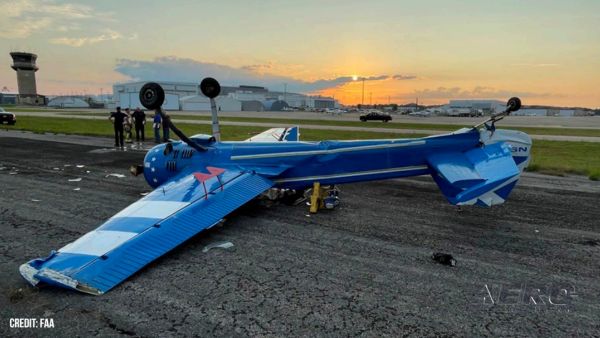Thu, Feb 01, 2024
...Loss Of Airplane Control While Performing Aerobatic Maneuvers, Which Resulted In The Airplane Entering An Inverted Flat Spin
Location: Osteen, Florida Accident Number: ERA22FA384
Date & Time: August 24, 2022, 16:39 Local Registration: N263MX
Aircraft: MXR Technologies MX2 Aircraft Damage: Substantial
Defining Event: Loss of control in flight Injuries: 2 Fatal
Flight Conducted Under: Part 91: General aviation - Other work use

Analysis: The accident flight was part of a training and demonstration flight that included a series of aerobatic maneuvers. Flight track data for the accident flight revealed that the airplane departed and maneuvered for about 7 minutes before impacting terrain almost directly under the last data point. No linear ground scar was observed at the accident site, which was indicative of the airplane having descended nearly vertically to ground impact. Additionally, the wreckage was found in an inverted orientation. Examination of the wreckage revealed no evidence of a preimpact mechanical anomaly that would have precluded normal operation of the airplane structure, the flight controls, or the engine. Estimated weight and balance calculations revealed that the airplane’s weight and its aft center of gravity were likely at or near the limit for aerobatic flight.
Given the purpose of the flight, the flight track, and the orientation of the wreckage, it is likely that the pilot lost control of the airplane while performing aerobatic maneuvers and that the airplane inadvertently entered an inverted flat spin. A fracture of the elevator torque tube at the aft bulkhead opening corresponded with the elevator control surface being in the full nose-up position when the airplane impacted the ground, which would have been a position consistent with the pilot attempting to recover from an inverted flat spin. The airplane’s weight and aft center of gravity likely contributed to the pilot’s inability to recover from the spin. Thus, the inverted flat spin likely continued until the airplane impacted terrain.
Toxicology testing revealed subtherapeutic concentration of chlorpheniramine in the pilot’s blood, which likely did not cause significant symptoms. Hydrocodone and its active metabolites (hydromorphone and dihydrocodeine) were detected in the pilot’s urine but not in his blood, so they would not have had any therapeutic effect or side effect. Thus, the detected chlorpheniramine, hydrocodone, hydromorphone, and dihydrocodeine did not contribute to this accident.
Probable Cause and Findings: The National Transportation Safety Board determines the probable cause(s) of this accident to be -- The pilot’s loss of airplane control while performing aerobatic maneuvers, which resulted in the airplane entering an inverted flat spin that continued until the airplane impacted terrain.
More News
From 2021: The Inside Skinny On What Being An ANN Oshkosh Stringer Is All About By ANN Senior Stringer Extraordinare, Gene Yarbrough The annual gathering at Oshkosh is a right of p>[...]
Pilot Asked The Mechanic To Go For A Test Flight Around The Airport Traffic Pattern With Him For A Touch-And-Go Landing, And Then A Full-Stop Landing On May 7, 2025, about 1600 eas>[...]
From 2010 (YouTube Edition): Skiles Reflects On His Ring-Side Seat To An Historic Event Jeff Skiles, First Officer of US Airways Flight 1549, "The Miracle on the Hudson," was the g>[...]
“The FAA conducted a comprehensive safety review of the SpaceX Starship Flight 8 mishap and determined that the company has satisfactorily addressed the causes of the mishap,>[...]
Fuel Remaining A phrase used by either pilots or controllers when relating to the fuel remaining on board until actual fuel exhaustion. When transmitting such information in respon>[...]
 Oshkosh Memories: An Aero-News Stringer Perspective
Oshkosh Memories: An Aero-News Stringer Perspective NTSB Prelim: Diamond Aircraft Ind Inc DA 40 NG
NTSB Prelim: Diamond Aircraft Ind Inc DA 40 NG Classic Aero-TV: US Airways Jeff Skiles-Making History and Looking To The Future
Classic Aero-TV: US Airways Jeff Skiles-Making History and Looking To The Future Aero-News: Quote of the Day (05.26.25)
Aero-News: Quote of the Day (05.26.25) ANN's Daily Aero-Term (05.26.25): Fuel Remaining
ANN's Daily Aero-Term (05.26.25): Fuel Remaining



